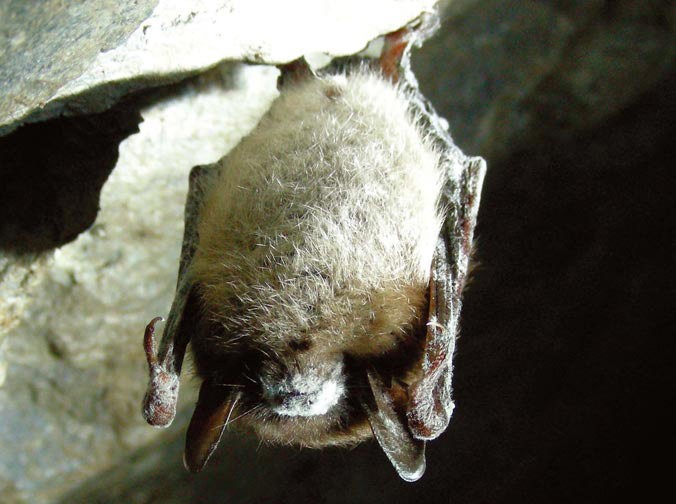It’s been five years since biologists found the first bats killed by white-nose syndrome in a cave near Albany, New York. It’s been four years since the first dead bats were found in Vermont, Massachusetts, and Connecticut.
Since then, the disease has spread throughout the East and Midwest, following a pattern that Jenny Dickson, a wildlife biologist for the Connecticut Department of Energy and Environmental Protection, describes as visible fungus the first year, high mortality the second year, then just a remnant population the third year.
“The good news is that not every bat in caves stricken by white-nose syndrome is dying,” said Mylea Bayless, director of conservation programs for Bat Conservation International in Austin, Texas.
On average, 88 percent of all hibernating bat species in caves and mines in New York, Vermont, Pennsylvania, Virginia, and West Virginia have died since white nose syndrome was first discovered, according to statistics gathered by Gregory Turner of the Pennsylvania Game Commission.
That grim number, however, hides the varying fortunes of the Northeast’s bat species affected by white nose syndrome.
Northern long-eared bats have been the most severely affected, said New York State Department of Environmental Conservation wildlife biologist Carl Herzog. “The loss is something like 98 percent.” This species is close to being extirpated, or going extinct regionally, in the Northeast.
But eastern small-footed bats, which were rare before white-nose syndrome, and the federally endangered Indiana bat, have fared better than some feared, with the Indiana bat declining 72 percent.
The little brown bat, which before white-nose syndrome was the most common bat in the Northeast, has suffered mortality rates of 90 percent or more in most areas.
In contrast, big browns bats have taken over as the most common bat species in most places in the Northeast, although their numbers have declined by 41 percent. Researchers don’t know why big brown bats are not dying at the same rate as the other species. It may be because they hibernate in the warmer, drier parts of the cave, or because they don’t huddle together as closely, or because they start hibernating later and leave hibernation sooner.
The region’s three bat species that migrate south instead of hibernating have not been affected by whitenose syndrome.
Vermont moved quickly to get the little brown bat and the northern long-eared bat listed as endangered species, said Scott Darling, wildlife management program director with the Vermont Department of Fish and Wildlife. An endangered species listing for the tricolored bat is underway and should be completed this summer.
The listings, he said, are “an attempt to reduce the non-disease-related mortality,” such as someone killing a colony in an attic.
Listings for these species are underway or under consideration in most of the states in the Northeast, Darling said.
Most states are also asking the public to report any summer bat colonies to the state wildlife department. In Vermont, this request turned up “a tepid ray of hope,” Darling said. Some of the reported colonies were indeed little brown bats, and some little brown bat colonies had as many as 100 animals. Plus, he said, “They were having pups.”
This winter in New York, surveys of hibernation sites showed some population increases. Hailes Cave, where the first bats killed by white-nose syndrome were found, is a good example. That cave had 16,000 bats according to a survey immediately before white nose struck, Herzog said. The first year after white nose was discovered, the population was down to 1,100 bats. At the end of the winter of 2010-2011, it was up to 1,500. That was perhaps a statistical wobble, but at the end of this winter, there were up to 2,400 bats.
What the Vermont and New York findings mean is still unclear. Are bats moving from other locations to hibernation and maternity sites that were temporarily unoccupied because of the die-off? Are bats that once hibernated deep inside caves moving to locations closer to the front? Are these bats resistant to white-nose syndrome, or will they succumb in the infected caves?
The wildlife departments of the northeastern states are cooperating in a banding project that will allow them to more easily track the movement of bats between hibernation sites and perhaps unravel the mystery of the bats’ possible rebound.
Said Emily Brunkhurst, wildlife biologist with the New Hampshire Department of Fish and Game, “It’s nice to have a little bit of hope, because basically, it’s very depressing.”
To learn more about white-nose syndrome, read “Bats on the Brink” on the Northern Woodlands website and "Bats Take It on the Nose."



Discussion *